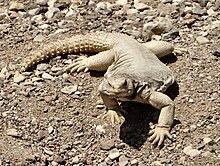Uromastyx aegyptia
| Uromastyx aegyptia | |
|---|---|

| |
| Scientific classification | |
| Domain: | Eukaryota |
| Kingdom: | Animalia |
| Phylum: | Chordata |
| Class: | Reptilia |
| Order: | Squamata |
| Suborder: | Iguania |
| Family: | Agamidae |
| Genus: | Uromastyx |
| Species: | U. aegyptia
|
| Binomial name | |
| Uromastyx aegyptia (Forskål, 1775)
| |
| Synonyms | |
Uromastyx aegyptia is a species of lizard in the family Agamidae. The species is endemic to North Africa and the Middle East.[1]
Common names
[edit]Common names for U. aegyptia include Egyptian mastigure,[3] Egyptian spiny-tailed lizard,[1] and, when referring to the subspecies Uromastyx aegyptia leptieni (see below), Leptien's mastigure.[3]
Description
[edit]U. aegyptia is one of the largest members of the genus, with average lengths of 76 cm (30 in) for males.
Geographic range and conservation status
[edit]U. aegyptia can be found in Egypt east of the Nile,[1][4] Israel, Syria, Jordan, the Arabian Peninsula, Iraq, and Iran. It has a patchy distribution and is rare in most parts of its range. It is believed to be in decline because of habitat loss and over-harvesting.[1]
Subspecies
[edit]Three subspecies are recognized as being valid, including the nominotypical subspecies.[3]
- Uromastyx aegyptia aegyptia (Forskål, 1775)
- Uromastyx aegyptia leptieni Wilms & Böhme, 2000
- Uromastyx aegyptia microlepis Blanford, 1874

Etymology
[edit]The subspecific name, leptieni, is in honor of German herpetologist Rolf Leptien.[5]
Economic use
[edit]U. aegyptia is locally known as dhab or ḍabb (Arabic: ضب). Its strong skin made good leather for the bedouins, while its meat was often considered as an alternative source of protein.[6]
Habitat
[edit]U. aegyptia lives in open, flat, gravelly, stony, and rocky areas at elevations up to 1,500 m (4,900 ft) above sea level.[1]
References
[edit]- ^ a b c d e f Wilms, T. [in German]; Eid, E.K.A.; Al Johany, A.M.H; Amr, Z.S.S.; Els, J.; Baha El Din, S. [in German]; Disi, A.M.; Sharifi, M.; Papenfuss, T.; Shafiei Bafti, S.; Werner, Y.L. (2017) [errata version of 2012 assessment]. "Uromastyx aegyptia ". IUCN Red List of Threatened Species. 2012: e.T164729A115304711. doi:10.2305/IUCN.UK.2012.RLTS.T164729A1071308.en. Retrieved 20 February 2022.
- ^ "Appendices | CITES". cites.org. Retrieved 2022-01-14.
- ^ a b c d Uromastyx aegyptia at the Reptarium.cz Reptile Database. Accessed 23 February 2022.
- ^ Baha el Din, Sherif (2006). A Guide to Reptiles & Amphibians of Egypt. Cairo: The American University in Cairo Press. ISBN 978-9774249792.
- ^ Beolens, Bo; Watkins, Michael; Grayson, Michael (2011). The Eponym Dictionary of Reptiles. Baltimore: Johns Hopkins University Press. xiii + 296 pp. ISBN 978-1-4214-0135-5. (Uromastyx leptieni, p. 155).
- ^ Ghose, Tia (2014-03-05). "Leapin' Lizards! Medieval Arabs Ate the Scaly Creatures". LiveScience.com. Retrieved 2015-04-20.
Further reading
[edit]- Forskål P (1775). Descriptiones Animalium, Avium, Amphibiorum, Piscium, Insectorum, Vermium; quæ in Itinere Orientali Observit. Copenhagen: Möller. 164 pp. (Lacerta ægyptia, new species, p. 13). (in Latin).
External links
[edit]- Egyptian Spiny-Tail Agama, Sea Dwellers & Friends.

